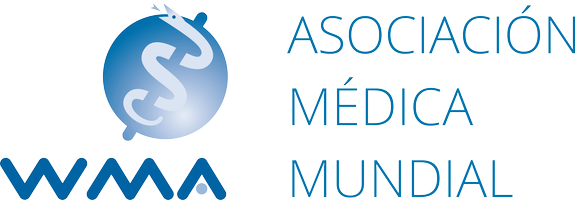Physicians_and_Pharmacists_in_Medical_Theraphy-Oct2010
Copiar PDF
1
THE WORLD MEDICAL ASSOCIATION, INC.
WMA STATEMENT
ON
THE RELATIONSHIP BETWEEN PHYSICIANS AND
PHARMACISTS IN MEDICAL THERAPY
Adopted by the 51st
World Medical Assembly, Tel Aviv, Israel, October 1999
and amended by the WMA General Assembly, Vancouver, Canada, October 2010
INTRODUCTION
The goal of pharmacological treatment is to improve patients´ health and quality of life. Optimal
pharmacological treatment should be safe, effective and efficient. There should be equity of access
to this kind of treatment and an accurate and up-to-date information base that meets the needs of
patients and practitioners.
Pharmacological treatment has become increasingly complex, often requiring the input of a multi-
disciplinary team to administer and monitor the chosen therapy. In the hospital setting the inclusion
of a clinical pharmacist in such a team is increasingly common and helpful. The right to prescribe
medicine should be competency based and ideally the responsibility of the physician.
Physicians and pharmacists have complementary and supportive responsibilities in achieving the
goal of providing optimal pharmacological treatment. This requires communication, respect, trust
and mutual recognition of each other’s professional competence. Access by both physicians and
pharmacists to the same accurate and up-to-date information base is important to avoid providing
patients with conflicting information.
Physicians and pharmacists must provide quality service to their patients and ensure safe use of
drugs. Therefore collaboration between these professions is imperative, including with respect to
the development of training and in terms of information sharing with one another and with patients.
It is necessary to keep an open and continued dialogue between physicians’ and pharmacists’
representative organizations in order to define each profession’s respective functions and promote
the optimal use of drugs within a framework of transparency and cooperation, all in the best
interests of patients.
THE PHYSICIAN’S RESPONSIBILITIES
Diagnosing diseases on the basis of the physician’s education and specialized skills and
competence.
Assessing the need for pharmacological treatment and prescribing the corresponding medicines in
consultation with patients, pharmacists and other health care professionals, when appropriate.
Vancouver, October 2010 Physicians and Pharmacists in Medical Therapy/Oct2010
2
Providing information to patients about diagnosis, indications and treatment goals, as well as action,
benefits, risks and potential side effects of pharmacological treatment. In the case of off-label
prescriptions the patient must be informed about the character of the prescription.
Monitoring and assessing response to pharmacological treatment, progress toward therapeutic goals,
and, as necessary, revising the therapeutic plan in collaboration with pharmacists, other health
professionals and, when appropriate, caregivers.
Providing and sharing information in relation to pharmacological treatment with other health care
practitioners.
Leading the multi-disciplinary team of health professionals responsible for managing complex
pharmacological treatment.
Maintaining adequate records for each patient, according to the need for therapy and in compliance
with legislation respecting confidentiality and protecting the patient’s data.
Where practically possible, actively participating in establishing electronic drug delivery systems
within their workplace and supporting those systems with their professional knowledge.
Maintaining a high level of knowledge of pharmacological treatment through continuing
professional development.
Ensuring safe procurement and storage of medicines that the physician is required to supply or
permitted to dispense.
Reviewing prescription orders to identify interactions, allergic reactions, contra-indications and
therapeutic duplications.
Reporting adverse reactions to medicines to health authorities, in accordance with national
legislation.
Monitoring and limiting, where appropriate, prescriptions of medications that may have addictive
properties.
Documenting adverse reactions to medicines in the patient’s medical record.
THE PHARMACIST’S RESPONSIBILITIES
Ensuring safe procurement, adequate storage and dispensing of medicines in compliance with the
relevant regulations.
Providing information to patients, which may include the information leaflet, name of the medicine,
its purpose, potential interactions and side effects, as well as correct usage and storage.
Reviewing prescription orders to identify interactions, allergic reactions, contra-indications and
therapeutic duplications. Concerns should be discussed with the prescribing physician but the
pharmacist should not change the prescription without consulting the prescriber.
Vancouver, October 2010 Physicians and Pharmacists in Medical Therapy/Oct2010
3
Discussing medicine-related problems or concerns with regard to the prescribed medicines when
appropriate and when requested by the patient.
Advising patients, when appropriate, on the selection and the use of non-prescription medicines and
the patient’s management of minor symptoms or ailments. Where self-medication is not appropriate,
advising patients to consult their physician for diagnosis and treatment.
Participating in multi-disciplinary teams concerning complex pharmacological treatment in
collaboration with physicians and other health care providers, typically in a hospital setting.
Reporting adverse reactions to medicines to the prescribing physician and to health authorities in
accordance with national legislation.
Providing and sharing general as well as specific medicine-related information and advice with the
public and health care practitioners.
Maintaining a high level of knowledge of pharmacological treatment through continuing
professional development.
CONCLUSION
The patient will best be served when pharmacists and physicians collaborate, recognizing and
respecting each other’s roles, to ensure that medicines are used safely and appropriately to achieve
the best outcome for the patient’s health.
!!!
